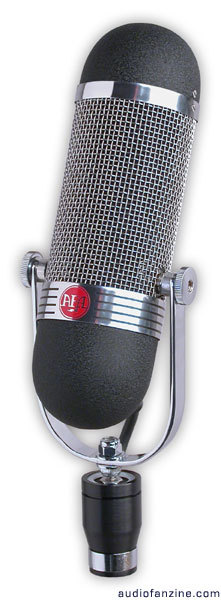View other reviews for this product:
« Best in its price range. »
Published on 06/19/12 at 18:02The AEA R84 ribbon microphone is a passive (watch out for ghosts at 48v!), The original model was built by RCA in the 40/50, is a contemporary of RCA 44 (also reprinted as the AEA 44 ).
It is a micro "general purpose". Unlike the static and moving coil, ribbon microphones are less often referred to a particular type of source in their design, although as Audio Technica offers a model and a model singing "instrument" for its own range.
The sound of ribbon microphones comes from their very conception. It is a metal band very thin and light that is fixed in the gap of a strong magnet. This feature gives the first ribbon microphones a better transient response than the mobile coils (compare to an SM57 and you'll see what I mean), but softer than the static.
The other feature is the resonant frequency, the tuning of the tape. Unlike static echoing in the high (hence the exaggerated clarity and cruel some models like the U87), the resonance of the ribbon is placed in the extreme serious. This results in the audible frequency response that drops gradually rather neutral in the treble.
Rather neutral by paying attention to the proximity effect due to the directivity 8. With less than a meter from the source can be expected with an increase in serious use is not bad, especially since we can always remove them with an equalizer, a filter strip or a plugin.
Therefore Ribbon microphones sound "natural" and the R84 is a perfect example.
The microphones of the 50 fell rapidly in the acute (at 12K there was much left). That is why the static became more common, because more accurate and brighter. At the time of tapes and copies lossy characteristics were apréciables. Today, with digital we need as much treble.
In addition, improved manufacturing techniques, and using powerful neodymium magnets provide an extended response. In fact, if you look at the curve provided on the site of AEA, we find that the 20K is only 6dB below 1K.
Suffice to say that the mic does not lack acute. It only return like in real life, and enough to add with an equalizer.
Warning: These microphones are fragile as sensitive to wind and 48v. Do not run with (or else in his bag), do not put it in front of a fan, this might relax the tape and sent straight into the nécessiterai an SAV. For decision-voice, the filter is just antipop mandatory, and keeps the singer at a distance that keeps control of the proximity effect.
OVERALL OPINION
It's been six months since I use virtually everything. It is the centerpiece of my setup. I always dreamed of having a ribbon microphone and it largely fills my expectations.
I have tried a lot of microphones. I loved the softness of the classical dynamics in frequency and accuracy of static. With the R84 I have both.
I always had trouble with static. Especially the U87. I know this is a reference, but I think this microphone is so precise that it looks more like judging the source of the return. It's cold, and when the source has the slightest defect, he puts forward.
This is not the case of R84. He respects the source as it is. It does not put forward faults, not exaggerated sibilants, no sounds horrible mouth. It emphasizes the body and soul of the source.
For the first time I heard my Vox amp for recording as I heard in real life. Not the infamous boiled a SM57 that destroys transient when it crunch, not a static aggressiveness. So to say I could make believe I play it by passing the recording strong enough.
This observation is also valid for all sources. It makes an excellent room mic for drums, just put microphone perpendicular to the battery to recover the piece only.
Voice on the sound becomes very malleable. We can do as well as modern vintage sound, then we apply the appropriate treatments. The phrase "it is with the old one does the new" takes on its meaning and I will add "and not the reverse."
On acoustic guitars it is just amazing. proximity effect may even give body models using, and lack of acute pure is offset by the good transient response.
In addition, a small treble boost with an EQ provides the brightness of a static without aggressiveness. I use the Feq-50 Summit audio for that. I even find it's smarter to do this maneuver rather than taking a static, since the EQ adds its own paw to her already beautiful.
I use the R84 with the 6176 and the Universal Audio LA-610MKII (which I also wrote test) is a neo-retro sound system perfect. The natural simplicity of tape, heat the tube amp and EQ and clarity of the 1176 transformers can get any sound I want.
The value for money is just great as soon as we research this aesthetic. For me it beats in the first round the TLM103 & Co in terms of tonal beauty and possibility of treatment.
I recommend it to any engineer who needs a microphone capable of doing everything, to catch everything. In addition there are variations, including a special version with a voice proximity effect and reduces an integrated pop screen filter, and an active version supplied with 48v for very weak sources.
However, I do not recommend it for a rapper or an R'n'B singer who needs a good microphone to his demos in a home studio. It is too fragile and does not give the result "immediate" that can give a blow for the neumann.
Last thing: if you do not have a pretty beefy preamp (70dB gain), and you do not have the means, think of the cloud lifter.



